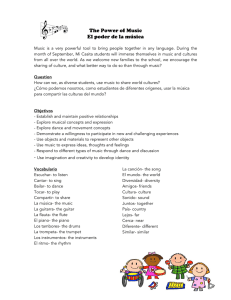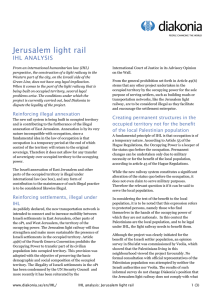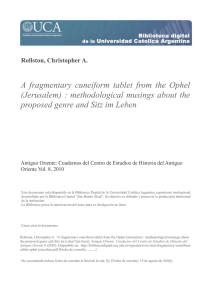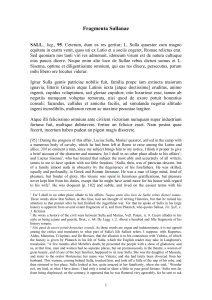Reavivando Al combate Drew Edward Davies Mayo, 2014
Anuncio
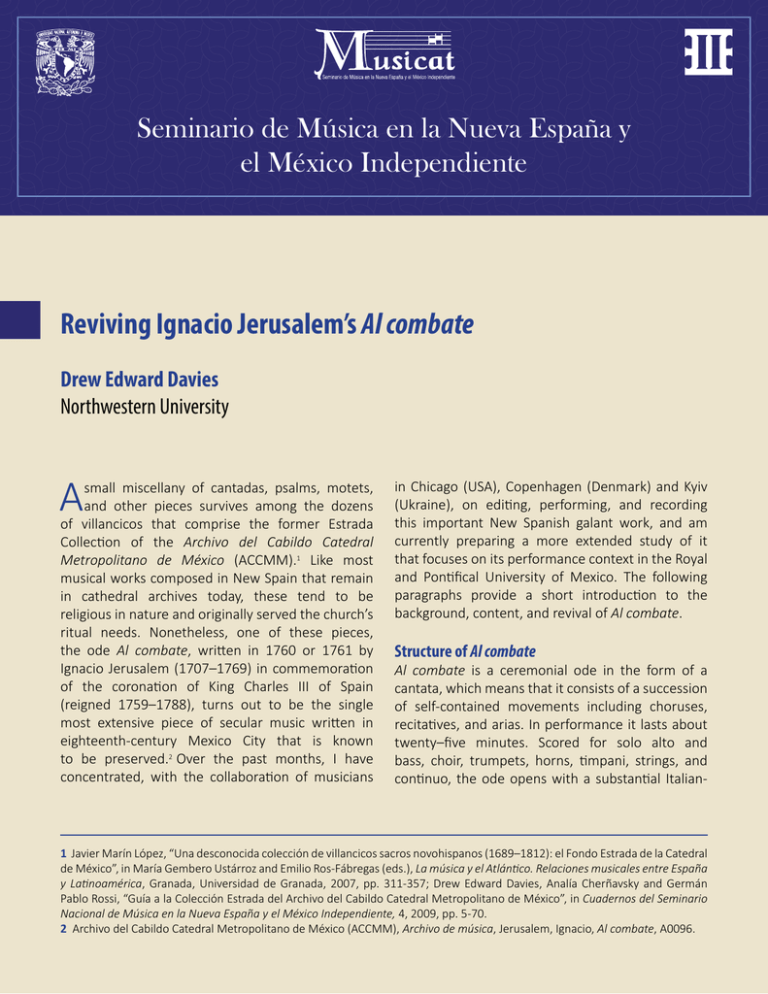
Seminario de Música en la Nueva España y el México Independiente Reviving Ignacio Jerusalem’s Al combate Drew Edward Davies Northwestern University A small miscellany of cantadas, psalms, motets, and other pieces survives among the dozens of villancicos that comprise the former Estrada Collection of the Archivo del Cabildo Catedral Metropolitano de México (ACCMM).1 Like most musical works composed in New Spain that remain in cathedral archives today, these tend to be religious in nature and originally served the church’s ritual needs. Nonetheless, one of these pieces, the ode Al combate, written in 1760 or 1761 by Ignacio Jerusalem (1707–1769) in commemoration of the coronation of King Charles III of Spain (reigned 1759–1788), turns out to be the single most extensive piece of secular music written in eighteenth-century Mexico City that is known to be preserved.2 Over the past months, I have concentrated, with the collaboration of musicians in Chicago (USA), Copenhagen (Denmark) and Kyiv (Ukraine), on editing, performing, and recording this important New Spanish galant work, and am currently preparing a more extended study of it that focuses on its performance context in the Royal and Pontifical University of Mexico. The following paragraphs provide a short introduction to the background, content, and revival of Al combate. Structure of Al combate Al combate is a ceremonial ode in the form of a cantata, which means that it consists of a succession of self-contained movements including choruses, recitatives, and arias. In performance it lasts about twenty–five minutes. Scored for solo alto and bass, choir, trumpets, horns, timpani, strings, and continuo, the ode opens with a substantial Italian- 1 Javier Marín López, “Una desconocida colección de villancicos sacros novohispanos (1689–1812): el Fondo Estrada de la Catedral de México”, in María Gembero Ustárroz and Emilio Ros-Fábregas (eds.), La música y el Atlántico. Relaciones musicales entre España y Latinoamérica, Granada, Universidad de Granada, 2007, pp. 311-357; Drew Edward Davies, Analía Cherñavsky and Germán Pablo Rossi, “Guía a la Colección Estrada del Archivo del Cabildo Catedral Metropolitano de México”, in Cuadernos del Seminario Nacional de Música en la Nueva España y el México Independiente, 4, 2009, pp. 5-70. 2 Archivo del Cabildo Catedral Metropolitano de México (ACCMM), Archivo de música, Jerusalem, Ignacio, Al combate, A0096. style overture in three movements, which can also stand alone as a symphony.3 The body of the work, as seen in Table 1, includes two pairs of recitatives and arias framed by celebratory choruses, which themselves are introduced by recitatives. The two solo arias feature da capo form, lyricism, light accompaniment, and openness to ornamentation, and resemble galant opera seria arias in form and style.4 The choruses, both in D major, signal the pomp and majesty of the regal context and bring Handel’s coronation music for King George II to 1. Sinfonia 2. Recitative (bass) “Al combate” 3. Chorus “A la competencia” 4. Recitative (alto) “Italia, Francia y España” 5. Aria (alto) “Todas pueden alegar” 6. Recitative (bass) “Ya España victoriosa” 7. Aria (bass) “Propicia estrella” 8. Recitative (alto) “El vínculo altamente establecido” 9. Chorus “Mexicana Minerva” mind, especially Jerusalem’s final chorus, which takes the character of a stately minuet. Al combate, is technically not a coronation ode, as it was not used in the coronation itself, but rather as a ceremonial work in honor of Charles III performed at a poetry competition at the Royal and Pontifical University of Mexico in January 1761. Some years after Jerusalem composed this occasional work, the two solo arias were rewritten as Latin responsories for the Feast of the Virgin of Guadalupe and inserted into Jerusalem’s cycle of pieces for that celebration dated 1764. It is likely that Antonio Juanas created these contrafacta, as the manuscript scores appear to be in his handwriting, and he had a precedent of adapting music on other occasions.5 Many examples of similar secularto-sacred contrafacta exist in the New Spanish repertoire, as well as in Catholic sacred music throughout Europe. The aria “Todas pueden alegar” from Al combate was reworked as the responsory Quae est ista quae progreditur (A0587.05), and “Propicia estrella” became the responsory Quae est ista que ascendit (A0587.02).6 Craig Russell’s edition of Quae est ista quae ascendit has been recorded by the California-based vocal group Chanticleer.7 Incidentally, Handel also reused music from his 3 Manuscript parts of the symphony, except the missing violin 2 part, are preserved at Durango Cathedral, MS. Mús. 257. See Drew Edward Davies, Catálogo de la Colección de Música del Archivo Histórico de la Arquidiócesis de Durango, México, Universidad Nacional Autónoma de México – Instituto de Investigaciones Estéticas and Apoyo al Desarrollo de Archivos y Bibliotecas de México, 2013. 4 On these stylistic characteristics, see Daniel Heartz, Music in European Capitals: The Galant Style 1720-1780, New York, Norton, 2003. 5 Drew Edward Davies, “Reinventando la música de Mateo Tollis de la Rocca: Una edición de Voce mea ad Dominum clamavi (1777/1797) con comentarios,” Cuadernos del Seminario Nacional de Música en la Nueva España y el México Independiente, 3, 2008, pp. 24-53. 6 On the score of Quae est ista quae ascendit appears “Este Responsorio es del M.tro Jerusalem, sacado de una Area, q.e comienza Todas pueden alegarle” [sic]. On the score of Quae est ista quae progreditur appears “Este responsorio es del M.tro Jerusalem, sacado de una Area, q.e comienza, Propicia Estrella”, ACCMM, Archivo de música, Jerusalem, Ignacio, A0587. 7 Chanticleer, Jerusalem: Matins for the Virgin of Guadalupe, 1764, Teldec 3984–21829–2 (1998). Pedro Gualdi, Interior de la Universidad de México, 1841. From Roberto L. Mayer “Los dos álbumes de Pedro Gualdi” in Anales del Instituto de Investigaciones Estéticas, vol. XVIII, n. 69, 1996, p. 96. coronation anthems, which were originally written in 1727, in his oratorio Deborah of 1733 and the 1732 revision of his oratorio Esther.8 Thus, thecontrafacta of Jerusalem were not inconsistent with musical practices of the period and not necessarily a result of the colonial context. The text of Al combate Al combate honors, from the perspective of the elite of the Royal and Pontifical University of Mexico, King Charles III of Spain (1716–1788), the Bourbon monarch who had served as the Spanish viceroy of Naples and Sicily before ascending the Spanish throne. Charles III exemplifies the reform minded Enlightenment monarch who promoted science, medicine, university education, and economic development in a time of decreasing influence of the church. The text of Al combate illustrates the erudition of New Spanish literature in this period and is one of the few texts set to music by a composer in New Spain that survives in printed form independently of the music.9 What is so interesting is that the text, written largely in the Spanish baroque culturist literary style of the seventeenth century, contrasts sharply with the music, which exudes the Italianate galant style typical of music composed around 1760. Thus, the text employs a rich symbolic language that draws upon both classical mythology and New Spanish literary history to construct a uniquely creole Mexican voice. It is fascinating that the text does not contain any references to Catholicism or to the Bible; in Europe, coronation music often features Old Testament references. 8 Winton Dean, Handel’s Dramatic Music and Masques, London, Oxford University Press, 1959, pp. 191–246. 9 Amorosa contienda de Francia, Italia y España sobre la augusta persona de el señor D. Carlos III exaltado al trono español… Mexico City, San Ildefonso Press, 1761. In the text, the Muses cooperate to hold a poetry competition (“certamen poético”)in honor of Charles III. The poets will not be divine, however, but rather Mexican: the elite of the University of Mexico, the “Mexican Minerva” as allegorized in the text. The fruit of this “loving competition” (“amorosa contienda”) are a set of poems that gloss the texts sung in Al combate. The text also brims with imagery of Castilian heraldry, including allusion to Charles III’s tri–national genealogy: his father, King Philip V of Spain, was born in France and his mother, Elisabeth Farnese, was Italian. The final message is that Charles III be crowned with the rays of Apollo, meaning that he reign with wisdom. The rhetorical contrast between the modern music and its archaic text suggests that the university is up to date in terms of progressive thought yet remains proud of its timeless, erudite academic tradition. Performances in Chicago and Kyiv and Recording The Chicago Arts Orchestra and Chorus, directed by Javier José Mendoza, gave the modern premiere of Al combate at St. Luke Church in Chicago, Illinois, on February 25, 2012, as the major work on a program entitled Transatlantic Voyages: 18th Century Galant Music in the Americas & Europe, part of its Rediscovered Treasures concert series.10 The program also included works by Santiago Billoni, Niccolò Jommelli, Johann Adolf Hasse, and the aria with obbligato flute, Cristal bello by Ignacio Jerusalem. I edited Al combate especially for this performance. Thanks to Maestro Mendoza’s enthusiastic support for this repertoire, the Chicago Arts Orchestra has recorded the work, with Navona Records, and that album is now available for purchase by mail or download,11 and may be listened to on Spotify. On May 30, 2012, the Liatoshynsky Ensemble of Classic Music, directed by Piotr Gasior, gave the European premiere of Al combate to an enthusiastic audience, including representatives from the Mexican Embassy, at the National Hall of Organ and Chamber Music of Ukraine in Kyiv. Gasior, who lives in Denmark, also programmed works by the Spanish composer Francisco Javier García Fajer, the Neapolitan David Perez, Haydn, Vivaldi, and Brixi on this exciting and, for Eastern Europe, revolutionary program. Although the existence of Al combate has been known for well over a decade, its significance to our understanding of New Spanish culture and society reveals itself slowly through the edition of its text and music, and the study if its historic circumstances. It reveals the elite creole context of vocal and orchestral music in the late colonial period and interconnections between Mexico City’s institutions, in addition to being an aesthetically powerful piece of galant music with broad appeal. My larger study of this work, currently in preparation, considers a broad interpretation of its poetic content within the context of the University of Mexico. 10 www.chicagoartsorchestra.org 11ahttp://www.amazon.com/Al-Combate-Rediscovered-Galant-Eighteenth-Century/dp/B00B5HK412/ref=sr_1_1_bnp_1_ mus?ie=UTF8&qid=1394468197&sr=8-1&keywords=al+combate


